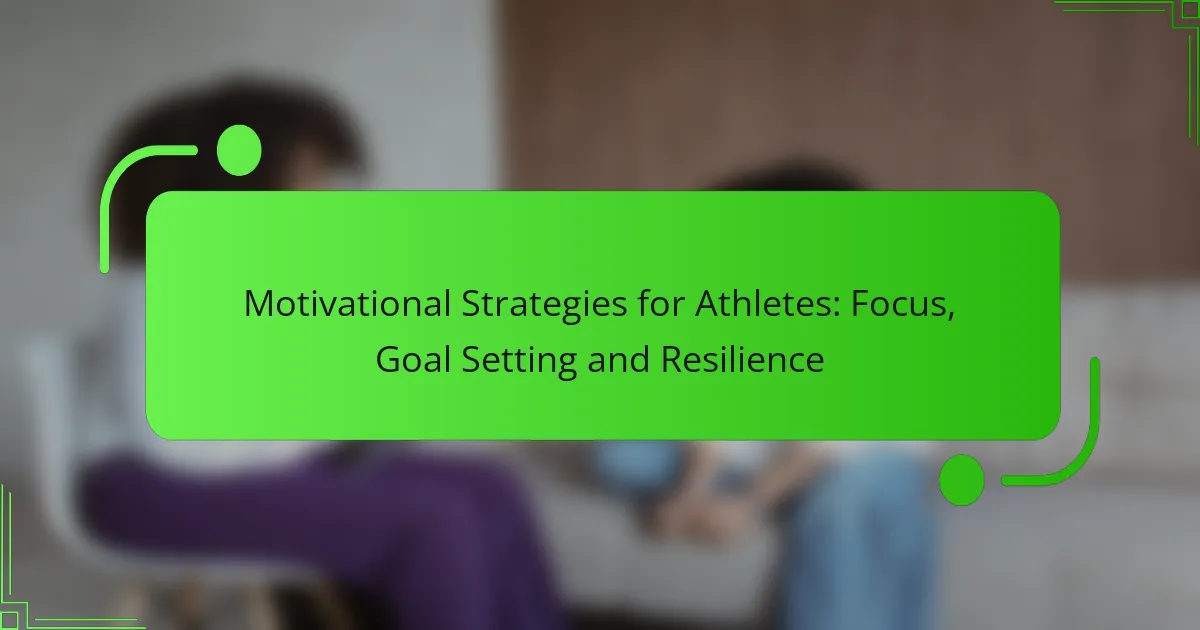Motivational strategies play a vital role in enhancing an athlete’s performance by fostering focus, goal setting, and resilience. By employing techniques such as mindfulness and visualization, athletes can sharpen their concentration and stay engaged. Additionally, setting SMART goals provides a clear framework for progress, while resilience helps them navigate challenges and maintain motivation throughout their journey.

What motivational strategies can athletes use to enhance focus?
Athletes can enhance focus through various motivational strategies that promote mental clarity and concentration. Techniques such as mindfulness, visualization, and routine development can significantly improve an athlete’s ability to stay present and engaged during training and competition.
Mindfulness techniques
Mindfulness techniques help athletes maintain focus by encouraging them to stay present in the moment. Practices such as deep breathing, meditation, and body scans can reduce anxiety and enhance concentration. Setting aside just a few minutes daily for mindfulness can lead to noticeable improvements in mental clarity.
To implement mindfulness, athletes can start with simple exercises like focusing on their breath for five minutes or practicing gratitude by reflecting on positive aspects of their training. This can help create a calm mindset before competitions.
Visualization practices
Visualization practices involve mentally rehearsing performance scenarios to enhance focus and confidence. Athletes can visualize themselves executing skills successfully, which can improve their actual performance. Research suggests that spending a few minutes each day visualizing specific goals can lead to better outcomes.
For effective visualization, athletes should find a quiet space, close their eyes, and vividly imagine their routines or competitions, incorporating all senses. This technique not only boosts focus but also helps in building a positive mindset.
Distraction management
Distraction management is crucial for maintaining focus during training and competitions. Athletes should identify common distractions, such as noise or negative thoughts, and develop strategies to minimize their impact. Techniques like creating a distraction list can help athletes recognize and address these interruptions proactively.
To manage distractions, athletes can use noise-canceling headphones, establish a focused environment, or practice positive self-talk to counter negative thoughts. Regularly reviewing and adjusting these strategies can enhance overall focus.
Routine development
Routine development provides structure and predictability, which can enhance an athlete’s focus. Establishing pre-competition rituals or training routines helps athletes mentally prepare and enter a focused state. Consistency in routines can signal the brain to switch into performance mode.
To create effective routines, athletes should include warm-up exercises, mental preparation techniques, and specific rituals that resonate with them. Keeping these routines consistent can lead to improved focus over time.
Environmental adjustments
Environmental adjustments can significantly influence an athlete’s ability to focus. Creating a conducive training space by minimizing clutter, controlling lighting, and reducing noise can enhance concentration. Athletes should assess their environments and make necessary changes to support their focus.
Simple adjustments, such as training in a quiet area, using appropriate lighting, or even choosing specific colors in their training space, can lead to better focus. Regularly evaluating the training environment ensures it remains optimal for performance.

How can goal setting improve athletic performance?
Goal setting can significantly enhance athletic performance by providing clear objectives and a structured approach to training. When athletes set specific, measurable, achievable, relevant, and time-bound (SMART) goals, they create a roadmap that guides their efforts and motivates them to push their limits.
SMART goals framework
The SMART goals framework is a widely recognized method for setting effective objectives. Each goal should be Specific, Measurable, Achievable, Relevant, and Time-bound. For instance, instead of saying “I want to run faster,” a SMART goal would be “I will improve my 5K time by 30 seconds within three months.” This clarity helps athletes focus their training efforts.
Using the SMART framework encourages athletes to break down larger ambitions into smaller, manageable targets. This approach not only makes the goals feel more attainable but also provides opportunities for celebrating small victories along the way.
Short-term vs long-term goals
Short-term goals are immediate objectives that can be achieved within days or weeks, while long-term goals span several months or years. Balancing both types is crucial for sustained motivation and progress. For example, a short-term goal might be to complete a specific workout routine, while a long-term goal could be qualifying for a national competition.
Short-term goals help maintain focus and momentum, while long-term goals provide a vision for the athlete’s career. Athletes should regularly review and adjust their goals to ensure they remain aligned with their evolving aspirations.
Tracking progress and adjustments
Regularly tracking progress is essential for understanding how well an athlete is meeting their goals. This can be done through training logs, performance metrics, or apps designed for athletes. By monitoring their advancements, athletes can identify patterns, strengths, and areas needing improvement.
Adjustments may be necessary if an athlete is not progressing as expected. For example, if a runner is consistently missing their pace goals, they might need to reassess their training plan or recovery strategies. Flexibility in goal setting allows athletes to adapt and stay on course.
Accountability partnerships
Having an accountability partner can enhance commitment to goals. This could be a coach, teammate, or even a friend who shares similar aspirations. Regular check-ins and discussions about progress can motivate athletes to stay focused and accountable.
Accountability partnerships can also provide emotional support during challenging times. When athletes face setbacks, having someone to encourage them can make a significant difference in maintaining motivation and resilience.

What role does resilience play in an athlete’s journey?
Resilience is crucial for athletes as it enables them to bounce back from challenges and maintain focus on their goals. It involves adapting to setbacks, managing stress, and sustaining motivation throughout their athletic careers.
Overcoming setbacks
Setbacks are a natural part of an athlete’s journey, whether due to injuries, losses, or performance slumps. Resilient athletes view these challenges as opportunities for growth rather than insurmountable obstacles. Developing a mindset that embraces failure can help athletes learn valuable lessons and improve their future performances.
To effectively overcome setbacks, athletes should analyze what went wrong, adjust their training or strategies, and set realistic recovery goals. This process can involve seeking feedback from coaches or peers to gain new perspectives.
Building mental toughness
Mental toughness is the ability to stay focused and composed under pressure. Athletes can build this trait through consistent practice, visualization techniques, and positive self-talk. Engaging in regular mental training can enhance their capacity to handle stress during competitions.
One effective method is to simulate high-pressure situations during training, allowing athletes to practice their responses. Setting incremental challenges can also help in gradually increasing their mental resilience.
Emotional regulation strategies
Emotional regulation is vital for athletes to maintain composure and focus during competitions. Techniques such as mindfulness, breathing exercises, and journaling can help manage emotions effectively. These strategies allow athletes to recognize their feelings and respond appropriately rather than react impulsively.
Incorporating short mindfulness sessions before training or competitions can improve emotional control. Athletes should also practice identifying triggers that may lead to negative emotions and develop personalized coping mechanisms.
Support systems
A strong support system is essential for fostering resilience in athletes. This includes coaches, teammates, family, and friends who provide encouragement and constructive feedback. Having a reliable network can help athletes navigate challenges and maintain motivation during tough times.
To build an effective support system, athletes should actively communicate their needs and seek out individuals who understand their goals. Participating in team-building activities can also strengthen bonds and create a more supportive environment.

What are the prerequisites for effective motivational strategies?
Effective motivational strategies for athletes require a strong foundation in self-awareness and an understanding of personal motivations. These prerequisites enable athletes to set meaningful goals and develop resilience in the face of challenges.
Self-awareness development
Self-awareness is the ability to recognize one’s strengths, weaknesses, and emotional triggers. Athletes can enhance self-awareness through reflective practices such as journaling, mindfulness, or seeking feedback from coaches and peers. This understanding helps athletes identify areas for improvement and tailor their training approaches.
To develop self-awareness, athletes should regularly assess their performance and emotional responses during training and competition. Techniques like video analysis or performance reviews can provide insights into their behaviors and decision-making processes. This ongoing evaluation fosters a deeper connection to their athletic journey.
Understanding personal motivations
Understanding personal motivations involves identifying what drives an athlete to pursue their sport. This could range from intrinsic factors like passion and enjoyment to extrinsic factors such as recognition or financial rewards. Knowing these motivations helps athletes stay committed during tough times.
To clarify personal motivations, athletes can create a list of their goals and the reasons behind them. For instance, an athlete may aspire to improve their performance for personal satisfaction or to compete at a higher level for potential sponsorship opportunities. This clarity can guide their training focus and decision-making.

How can athletes measure the effectiveness of their motivational strategies?
Athletes can measure the effectiveness of their motivational strategies by evaluating performance outcomes, engaging in self-reflection, and seeking feedback from coaches. These methods provide insights into how well motivation translates into results and areas for improvement.
Performance metrics
Performance metrics are quantifiable measures that help athletes assess their progress and effectiveness of motivational strategies. Common metrics include personal best times, scores, and rankings. Tracking these over time can reveal trends that indicate whether motivation is positively impacting performance.
For example, a runner might monitor their race times across several competitions to see if motivational techniques, such as visualization or positive affirmations, correlate with improved results. Maintaining a log of these metrics can help identify successful strategies and areas needing adjustment.
Self-reflection techniques
Self-reflection techniques encourage athletes to analyze their thoughts, feelings, and behaviors related to motivation. Journaling can be an effective method, allowing athletes to document their experiences and emotional responses during training and competition. This practice helps in recognizing patterns and understanding what motivates them most.
Additionally, athletes can use guided questions to facilitate reflection, such as: What strategies helped me stay focused? Did I feel more resilient during challenging moments? This introspection can lead to more tailored motivational approaches in future training.
Feedback from coaches
Feedback from coaches is crucial for athletes to gauge the effectiveness of their motivational strategies. Coaches can provide objective assessments of performance and offer insights into how motivation influences training and competition outcomes. Regular check-ins can help athletes understand their strengths and areas for improvement.
To maximize the benefits of feedback, athletes should approach discussions with an open mind and be willing to implement suggested changes. This collaborative effort can enhance motivation and ultimately lead to better performance results.

What are advanced techniques for maintaining motivation during competition?
Advanced techniques for maintaining motivation during competition include mental conditioning, visualization, and self-talk. These strategies help athletes stay focused, set achievable goals, and build resilience against challenges.
Focus Techniques
Maintaining focus during competition is crucial for performance. Techniques such as mindfulness and concentration exercises can help athletes stay present and minimize distractions. For example, practicing deep breathing or using a focus cue word can enhance concentration during critical moments.
Additionally, athletes can create a pre-competition routine that includes specific mental and physical warm-ups. This routine can signal to their body and mind that it’s time to perform, helping to establish a focused mindset.
Goal Setting
Effective goal setting is a powerful motivational strategy. Athletes should set SMART goals—Specific, Measurable, Achievable, Relevant, and Time-bound. For instance, instead of saying “I want to improve,” an athlete might set a goal to “increase my sprint time by 2 seconds in the next month.”
Regularly reviewing and adjusting these goals can keep athletes motivated and on track. It’s also beneficial to break larger goals into smaller, manageable milestones to celebrate progress along the way.
Resilience Building
Building resilience is essential for athletes to cope with setbacks and maintain motivation. Techniques such as positive self-talk and reframing negative thoughts can help athletes view challenges as opportunities for growth. For example, instead of thinking “I failed,” an athlete might reframe it as “I learned what to improve for next time.”
Additionally, developing a strong support network of coaches, teammates, and mentors can provide encouragement and perspective during tough times. Engaging in regular reflection on experiences can also enhance resilience by helping athletes learn from both successes and failures.



